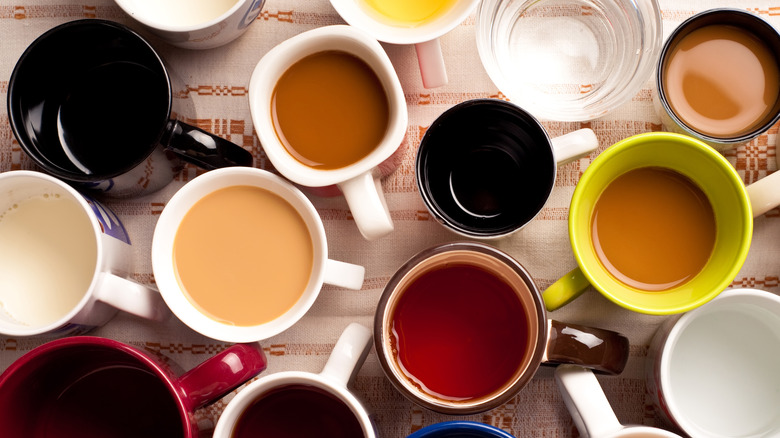It Turns Out Tea Cups And Coffee Mugs Look Different For A Reason
When you're brewing coffee or steeping tea, do you think much about the cup you're drinking from? You probably think more about the drink itself, which makes sense — the cup shouldn't be messing with the taste much unless it hasn't been washed properly. But historically, tea and coffee cups do have differences that change the way you put back your drink, even if it's in small ways. And these are still things that baristas keep in mind.
Tea cups tend to be smaller and wider, with lots of surface area to help the boiling water cool off faster while the tea steeps. When a cup has a wider surface area, more of the drink is exposed to the air and it loses more heat. A tea cup often has a flared rim (which means the edges stick out) for this same reason, to have slightly more surface area on top. On the contrary, coffee cups tend to be taller and narrower to keep the coffee hot as long as possible — it's often thought that boiling water can burn coffee, so slightly cooler (but still hot) water is used.
Short and stout
Not all teas are steeped with boiling water: green tea should steep at a much lower temperature, for example, although black teas and herbal teas should absolutely steep at hot, boiling temperatures. But generally, tea cups are designed to accommodate very, very hot teas. Culturally, tea cups are also smaller and wider because they're meant for a relaxed drinking session where you sip slowly and take in the flavors. They're also nearly always made of smooth porcelain because porous containers — like styrofoam cups, for example — can absorb some of the flavor.
Meanwhile, a cup of joe is treated like fuel — we drink it for caffeine boosts more than the flavor, and it's possible that we like the bitter taste of coffee because we associate it with caffeine, according to Food & Wine. Coffee cups used to be somewhat smaller, but that's changed — the average coffee mug is eight to ten ounces (or about 250 to 350 milliliters), and they can certainly get much bigger. Unless it's espresso, of course. It's also socially acceptable to drink coffee from styrofoam cups because they're more portable and the flavor is less important.
He chose... poorly
If you're just putting back a quick cup of coffee or tea in the morning or early afternoon before you get back to work, then will this matter? No, it probably won't. But if you're trying to become an aficionado and get the flavors just right, then you're beginning to focus on the small details to brew the perfect cup of tea or coffee. Here, your cup matters. So what should you look for?
With coffee, since the goal is to retain both heat and flavor, you might want to avoid simple ceramic mugs because they're more porous than porcelain or glass — they also might leak their own flavor into the coffee, and they're slightly harder to clean.
For tea, all the above tips should help you find a cup that helps with the flavor, but also consider a container with a thin lip so the tea can "glide" more smoothly onto your tongue and you're not "wasting" the flavor by chugging it all down at once. Unless you're using tea as a replacement for your morning coffee, as many people do, in which case you can probably use a coffee mug.


